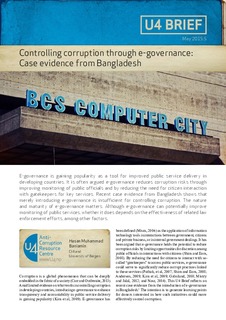| dc.contributor.author | Muhammad, Baniamin Hasan | |
| dc.date.accessioned | 2018-01-04T08:19:49Z | |
| dc.date.available | 2018-01-04T08:19:49Z | |
| dc.date.issued | 2015-05-04 | |
| dc.identifier | oai:www.cmi.no:5536 | |
| dc.identifier.citation | Bergen: Chr. Michelsen Institute (U4 Brief 2015:5) 4 p. | |
| dc.identifier.uri | http://hdl.handle.net/11250/2475041 | |
| dc.description.abstract | E-governance is gaining popularity as a tool for improved public service delivery in developing countries. It is often argued e-governance reduces corruption risks through improving monitoring of public officials and by reducing the need for citizen interaction with gatekeepers for key services. Recent case evidence from Bangladesh shows that merely introducing e-governance is insufficient for controlling corruption. The nature and maturity of e-governance matters. Although e-governance can potentially improve monitoring of public services, whether it does depends on the effectiveness of related law enforcement efforts, among other factors. | |
| dc.language.iso | eng | |
| dc.publisher | Chr. Michelsen Institute | |
| dc.relation | U4 Brief | |
| dc.relation | 2015:5 | |
| dc.relation.ispartof | U4 Brief | |
| dc.relation.ispartofseries | U4 Brief 2015:5 | |
| dc.relation.uri | https://www.cmi.no/publications/5536-controlling-corruption-through-e-governance | |
| dc.subject | E-Governance | |
| dc.subject | Public Sector | |
| dc.subject | Sector Work | |
| dc.subject | Bangladesh | |
| dc.title | Controlling corruption through e-governance: Case evidence from Bangladesh | |
| dc.type | Report | |
